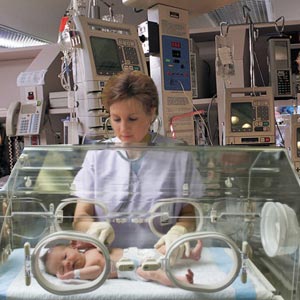 |
Like any other mom-to-be, you too look forward to having a completely smooth journey to motherhood. You are dutifully following doctor's advice regarding nutrition and overall well being to ensure as healthy a pregnancy as possible sans complication. You feel encouraged, secure and happy with the gynecologist's feedback regarding fetal development post every scheduled visit. Yet, the unpredictable pregnancy complication, premature birth of newborn which most women fear can happen.
It can be tough even for doctors to predict which pregnant women will give birth to premature babies. For, pregnant women with a normal pregnancy history are as much vulnerable as those with associated risk factors. This article is a guide to having a healthy pregnancy. It provides insight into factors that contribute towards the growing incidence of premature births with suggestions to minimize the risk.
Premature birth
Post confirmation of pregnancy, a pregnant woman progresses through pregnancy for an average length of 40 weeks or 280 days. There are three stages of pregnancy referred to as trimesters. A normal pregnancy ends with the infant delivered between 38-42 weeks. At this stage, the fetal organs are developed and the respiratory system is mature. An early ending of pregnancy, before the 37th week is termed as premature delivery, the birth of the baby is considered premature.
As such, premature infants may arrive weeks or even months ahead of scheduled date of delivery. The standard method of arriving at the probable date of delivery is by adding 280 days to the first day of your last menstrual period. The other method can be worked out in case you are aware when ovulation occurred, when you had intercourse and the date of conception.
Just add 266 days to get the probable date of delivery. About 12 % of babies (1 in 8) in the United States are born prematurely. Premature infants are at greater risks for devastating disabilities, illnesses and long-term health problems as compared to babies born at the right time.
Why premature births?
Any pregnant woman who is just doing completely fine can have premature labor or pre-term delivery. The pregnancy can end in premature births if the pregnant woman:
- Is younger than 17 years or above 35 years
- Is carrying twins, triplets or more
- Previously had more than three abortions.
- Has already delivered a premature baby
- Has certain uterine or cervical abnormalities
- Hasn't gained sufficient weight during pregnancy.
Lifestyle factors that put pregnant women at greater risks for premature birth of infants include smoking, consumption of alcohol, tobacco, illegal drugs (cocaine, marijuana, heroin etc) taken during pregnancy or taking medications without doctor's recommendation, suffering domestic violence physical, sexual or emotional abuse, experiencing high level of stress and anxiety, strenuous physical activity at home or office.
Pregnant women with certain medical conditions developed during pregnancy or prior to pregnancy are at a higher risk of delivering premature infants. Certain problems are maternal factors, fetal factors or both.
- Placenta abruptio, partial or complete separation of placenta from the uterus before delivery
- Rupture of membranes
- Weak cervix
- Maternal infections like urinary tract infections, vaginal infections, sexually transmitted infections
- Pregnant woman with high blood pressure, diabetes or obese
- Bleeding from the vagina after 20 weeks of pregnancy
- Gap between pregnancies is less than 6-9 months
- Excess amount of amniotic fluid
- Abdominal surgery during pregnancy
- Fetal congenital anomalies
Symptoms of premature birth
Adequate prenatal care, taking a multivitamin with folic acid every day beginning before commencement of pregnancy, avoiding alcohol or smoking are certain preventive measures every woman should adhere to. Apart from this, a pregnant woman should look out for signs and symptoms that can occur even before the due date of delivery.
Contractions: The tightening and hardening of the uterus every 10 minutes or less within 1 hour.
Water bag: Watery fluid discharge from vagina indicating that the water bag is broken.
Cramps: Constant or intermittent menstrual like cramps in the lower abdomen with or without diarrhea or gas.
Backache: Right below the waistline, constant or intermittent backache.
Pelvic pressure: The pressure can make the pregnant woman feel as if the baby is pushing down.
Vaginal discharge: Unusual, sudden leak of fluid from vagina, including spotting or bleeding.
Decreased fetal movements: The baby doesn't kick as often it used to.
Take help
If you can relate your situation to any of the signs and symptoms of premature birth and if the condition persists for more than one hour, it is best to call your gynecologist immediately. You will receive instructions with regard to further course of action. You may need to visit the hospital. Your doctor may also ask you to immediately empty your bladder, lie down on the left side, and drink several glasses of fluids, preferably water; these are attempts to delay labor.
On arrival, if the doctor is definite that you are experiencing preterm labor, you will be given medication to stop labor so your baby has more time to develop in the uterus. If not, you may be asked to go home. In case, the labor can't be stopped and continues to progress, it results in premature birth.
Ultrasound is used to monitor the length of the cervix. The contractions and their duration are monitored. Expectant mothers who show signs of premature birth are advised bed rest and extra fluids to stop premature contractions. Women with weak cervix are made to undergo strong sutures to close the cervix and they are removed only in the last month of pregnancy.
Bibliography / Reference:
|


